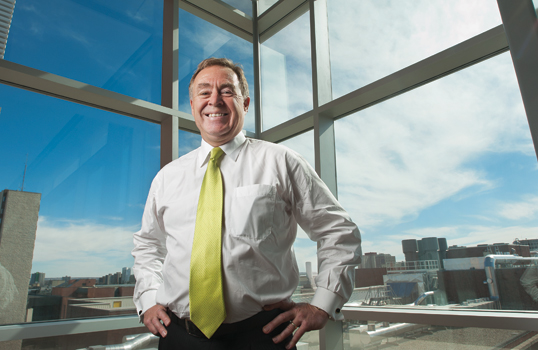
New chair of the Board of Governors, Douglas Goss, believes the U of A has a pivotal role to play in Alberta's economic evolution
A timely convergence of economic and political opportunity creates "a very exciting time for post-secondary education and especially for the University of Alberta," says Douglas Goss, '81 BCom, '84 LLB, the new chair of the Board of Governors."This province has about $75 billion in assets managed by Alberta Investment Management Corp.," he says. The sheer size of that portfolio, which includes pension fund reserves and the Alberta Heritage Savings Trust Fund, reveals the financial strength of the provincial government and its potential to make visionary investments in a province that, while economically strong, faces enormous challenges.
"Just try to find a jurisdiction, across this country or the U.S., that doesn't wish they had our assets," Goss muses.
In the short term, Alberta's economy may rise and fall on oil and gas prices and on the environmental politics of oilsands development, hydraulic fracturing of natural gas pools and pipeline construction.
But Goss looks beyond those immediate issues to a longer-term vision suggested last May, in the report of the Premier's Council for Economic Strategy, chaired by David Emerson, '68 BA, '70 MA.
"We must plan for the eventuality that oilsands production will almost certainly be displaced at some point in the future by lower-cost and/or lower-emissions alternatives," the report stated.
Rather than seeing our economy decline with an obsolescent industry, "Albertans' best chance for sustained prosperity will be to pioneer once again," the report said.
Fortunately, Alberta has developed a base of financial, human and infrastructural resources to enable such a transition. "The vision for the province has to be to ensure that it invests the bulk of its assets in a post-non-renewable-resources energy era - which is inevitable," Goss says.
Here he sees great opportunity for the U of A: "If we're going to compete successfully in a post-oil-and-gas world, we must invest in research and education - from kindergarten to Grade 12 and post-secondary institutions."
Such an educational and economic transformation will be expensive but rewarding. "This province has been given a lot," Goss says, then quickly adds: "To whom much is given, much is expected in return," quoting former U. S. president John F. Kennedy - who in turn was borrowing from the New Testament (Luke 12:48).
Goss is convinced that "the case is there" for the U of A to play a lead role in transforming the province but recognizes that it will turn crucially on government funding. "All we can do is lay out the case," he says. "Hopefully, the people in government are listening."
He calls the U of A "the flagship of the post-secondary system," but he advocates for the entire fleet. The recognition of education as a catalyst to Alberta's economic evolution "must include kindergarten to Grade 12, MacEwan and Athabasca University, the universities of Calgary and Lethbridge, plus NAIT and SAIT," he says.
The U of A's potential often has been linked to its excellent programs in engineering, environmental studies, medicine and the sciences. But along with such practical programs, the University's studies in social sciences and humanities hold equal value. Goss quotes Henry Marshall Tory, the U of A's first president, who spoke of "uplifting the whole people," and declares that "we need challenging thought, at the top of our game, across the board. Nobody should be left behind."
Beyond funding, Goss says, the future of the U of A depends on the future of the city of Edmonton. "We continue to have a challenge: to ensure that our city is eminently livable, as a place for people to visit and to live in, where people want to raise their children and, when they get those great ideas, will continue to live here."
How can our city attract and retain people who can help us develop as a centre of educational and economic innovation and progress? "Right now, we need a bit of a sell job to get the best people to come here and stay here," Goss says.
The U of A is interdependent with the wider community. "I've seen a lot of movement where the University has reached out to the business community, developers and politicians," Goss says - pointing to the U of A moving downtown into Enterprise Square and expanding to South Campus.
But entering established neighbourhoods can also create conflicts, as witness concerns recently expressed by residents living near South Campus.
"We can always do better," Goss acknowledges. "We need to be seen as acting in the best interests of the community."
That can be tricky, as the University must serve several stakeholders, Goss says. "Our job is to deliver the greatest possible return on investment to the people of Alberta - students, taxpayers and industry. We must keep pushing the envelope and, when we've done the best we can, push it a little further."
Yes, "there's lots of work to do" to attain the U of A's goal of being "a first-class institution that can compete with any in the world," Goss says. "The exciting part is that the potential is here."

We at New Trail welcome your comments. Robust debate and criticism are encouraged, provided it is respectful. We reserve the right to reject comments, images or links that attack ethnicity, nationality, religion, gender or sexual orientation; that include offensive language, threats, spam; are fraudulent or defamatory; infringe on copyright or trademarks; and that just generally aren’t very nice. Discussion is monitored and violation of these guidelines will result in comments being disabled.